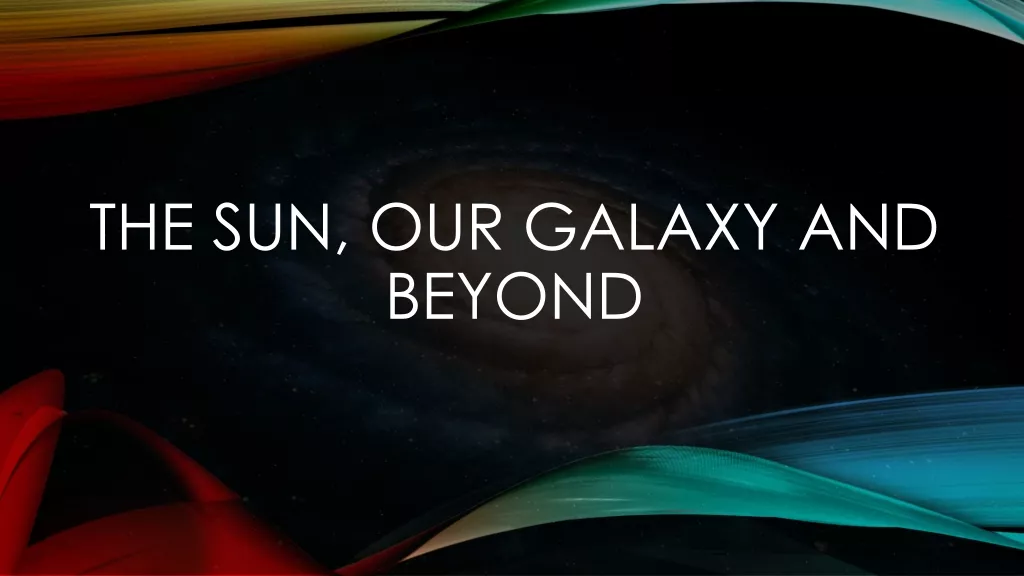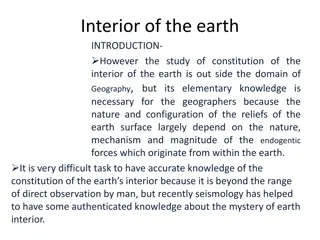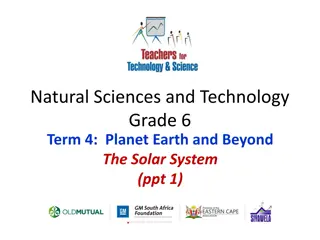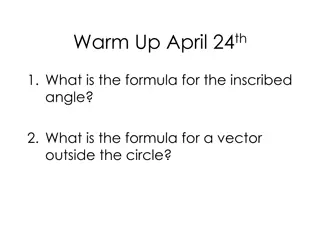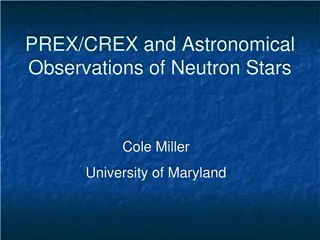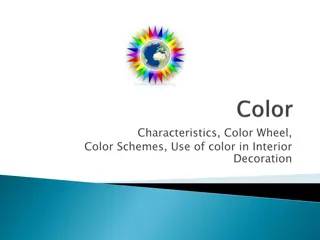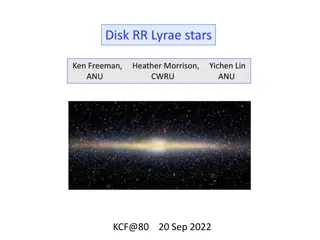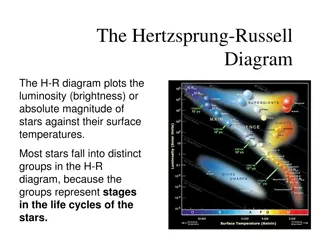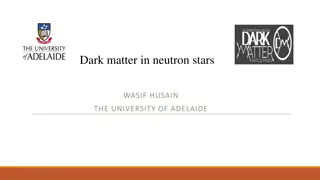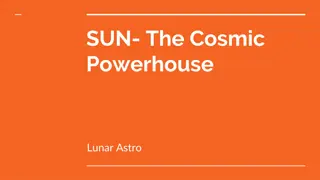Earth and Stars: Roundness, Circumference, Sun's Color, and Star Composition" (66 characters)
Discover why we know Earth is round, its circumference, the colors of the Sun and sky, how stars shine through fusion, what they are made of, and the Hertzsprung-Russell diagram for understanding stellar lifecycles. Explore fascinating facts about our planet and the celestial bodies that light up our night sky. (278 characters)
Uploaded on Sep 23, 2024 | 4 Views
Download Presentation

Please find below an Image/Link to download the presentation.
The content on the website is provided AS IS for your information and personal use only. It may not be sold, licensed, or shared on other websites without obtaining consent from the author.If you encounter any issues during the download, it is possible that the publisher has removed the file from their server.
You are allowed to download the files provided on this website for personal or commercial use, subject to the condition that they are used lawfully. All files are the property of their respective owners.
The content on the website is provided AS IS for your information and personal use only. It may not be sold, licensed, or shared on other websites without obtaining consent from the author.
E N D
Presentation Transcript
DSQ 1. How do we know the Earth is round? 2. What is the circumference of the Earth? 3. Why does the Sun appear yellow and the sky blue?
Star Cycle and Life Notes
Review Magnitude Apparent Magnitude The measure of how bright an object is from Earth Absolute Magnitude The luminosity of a star depending on the stars size and temperature. (not the brightness that we see from Earth) The star Sirius looks much brighter from earth even though its absolute magnitude is less than other nearby stars
How do stars shine? Nuclear fusion The process where nuclei of smaller atoms combine to form a larger nucleus. This process is constantly happening inside of a star which results in the brightness of the star. Star color is determined by the temperature. Brightness comes from temperature and what else .? Are all of these stars the same size? No! for example Betelgeuse is 700 times as big as the sun!
What are stars made of? Our sun is made of Hydrogen H2 (75%), Helium He (25%), and <.001% other metals. Other Stars in the Milky Way galaxy are around Hydrogen (71%), Helium (27%) and the rest is heavier metals. What causes the difference between our sun and other stars in the Milky Way?
Hertzsprung-Russell H-R Diagram Created in 1910 by Ejnar Hertzsprung and Henry Norris Russell to better understand stellar lifecycles. Stars of greater luminosity are toward the top of the diagram Stars with higher surface temperature are toward the left side of the diagram Temperature of stars determines their color, Blue being the hottest, then white, yellow, orange, and then finally red. Luminosity of stars is determined by their temperature (blue stars give off more light, red gives off the least amount) and by their size.
H-R Diagram activity You will be handed out 3-5 circle representing stars. Compare your stars with your neighbors and note the differences in temperature, brightness, and color. Look at the Star Chart Graph, There are two axes Temperature (K) and Brightness (# of Suns) Bring your stars up a couple students at a time and place them on the graph at the appropriate temperature and brightness.
Questions about the H-R diagram star chart Describe the general trend between temperature and brightness. What is the color and brightness of the most abundant stars? The rarest stars? What are the characteristics of the stars that do not conform to the graph s trend? In terms of the graph s trend, is our sun typical or exceptional? If you replaced the temperature scale on the graph s x-axis with a color scale, which color would be closest to the graph s origin and which would farthest away? In the stars that fit the general trend (these are often called Main Sequence stars), what relationship do you notice between color and expected lifetime?
Stellar Life Cycle Star Cycle Stars all follow the same basic steps All stars start as Nebulae and then enter the main sequence, after they run out of fuel, a star begins to die. Low Density Stellar Cycle Nebula Protostar Main Sequence Red Giant Planetary Nebula White Dwarf Black Dwarf High Density Stellar Cycle Nebula Protostar Main Sequence Red Supergiant Supernova Neutron or Blackhole
Nebula Clouds of dust made up of Hydrogen and Helium gases. Protostar Eventually a nebula will condense and contract and this forms a very dense area called a Protostar
Main Sequence Stars Stars spend most of their lives as main sequence stars. A star is a main sequence star as soon as it starts to fuse hydrogen into helium inside its core. The more massive a star is the shorter its lifespan is A star the size of our sun can last for billions of years. Massive stars have lifespans in the millions of years.
Red Giants & Supergiants If a main sequence star consumes most of its hydrogen fuel gravity will cause its core to collapse, its outer layers will expand and cool to form a Red Giant. A Red giant will have a core compose of Carbon which is fused from Helium in its second layer and has an outer layer of Hydrogen. If the star is massive enough, when it consumes its helium runs low it will again collapse and form a Red Supergiant with an Iron core and outer layers of Silicon, Oxygen, Neon, Carbon, Helium, and Hydrogen.
Planetary Nebula Some stars, around the size of our sun or smaller can not get hot enough fuse anything beyond helium. Once they run out of fusible Helium these stars lose the rest of their unfused gases into a planetary nebula White Dwarf The gases of the planetary nebula eventually move away from the stars core which when exposed is called a white dwarf. This core is mostly made of superhot, super dense carbon. White Dwarves are extremely small but very dense. White Dwarves can range from a blue-white (very hot Type O star) color to red (cooler Type M star) color. Comparison between a white dwarf IK Pegasi B, IK Pegasi A (left) , and our sun (right).
Supernova Stars with 10 times more mass than our sun form into supernovae (plural or supernova) when they run out of elements to fuse. Without the energy from nuclear fusion forcing the star to expand these red giant and supergiant stars will suddenly and almost instantaneously collapse inwards due to gravity generating massive amounts of heat and energy causing the star to explode. Supernovae can form into neutron stars or black holes. Supernovae release enough energy to form elements above Iron.
Neutron Star Neutron stars are left over after a star explodes. These stars are tiny only 20 km wide (Just this the distance from downtown Anchorage to Kincaid ice chalet is 17+km) A neutron star is enormously dense (1 tsp would weigh 1 billion tons) the atoms inside of a neutron star have almost no space in between them. Black Hole Black holes are formed from only the most massive and dense stars. The forces of gravity on the atoms in this star or so great they crush all matter together Electromagnetic radiation (even light) can not escape the high gravity from a black hole. Since there is no light from a black hole scientists can only infer their existence.
Recycling Matter Planetary Nebula These nebula have nothing do do with planets and were originally named because astronomers thought they were regions where planets were forming. They lose hydrogen and helium gas that can form new stars. Supernovae Explosions caused by supernovae cause dust and heavier elements to form Heavier elements and resulting waves travel through space until they collect into nebula and for into new planets


